The season finale of the immensely popular Breaking Bad is upon us, and we can’t stop thinking about seriously unstable bald men Heisenberg, Blue Sky, and all the crime-fueled craziness that has driven the show ever since a mild-mannered science teacher morphed into the Southwest’s most formidable drug kingpin. The dramatic allure of hard drugs in popular narratives is nothing new, however: from Burroughs’ Naked Lunch to Irvine Welsh’s Trainspotting, to the retroactively fictional James Frey book, A Million Little Pieces, drugs can be almost as important to the narrative as the characters who take them. And of course science fiction and fantasy has a brilliant track record when it comes to speculating on what kinds of memorably mind-bending substances might exist in the future or in alternate dimensions…
Here are ones we’ve all gotten hooked on.
Soma (Brave New World)

In Huxley’s famous novel, the fictional drug Soma has a veriety of effects; mostly, it seems to numb one’s perception of reality and dull one’s emotions. In the book, Huxley describes it as having “all the advantages of Christianity and alcohol, none of their defects.” Soma is an institutionalized drug that essentially runs this future society—in science fiction and fantasy, saying “yes” to drugs is sometimes mandatory. The movie Equilibrium sort of borrowed this idea with a drug called Prozium.
The Spice/Melange (Dune)
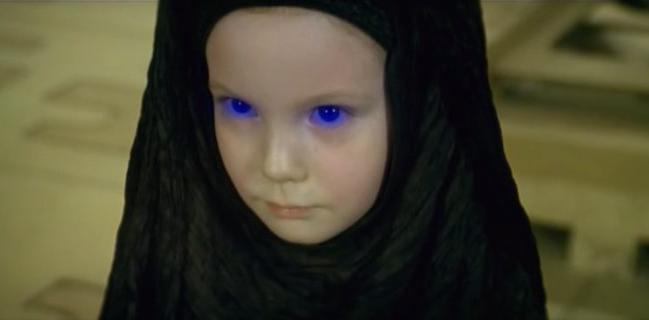
Here’s another culture-defining drug: this narcotic permeates almost every aspect of the Fremen culture insofar as it is primarily responsible for intergalactic commerce. The Spice is not only multi-flavored with a variety of uses, it also serves different functions in the narrative itself. Like all good fictional MacGuffins, the Spice is both the focus of much of the story but also imbedded in the fabric of the story itself. The Spice must flow, not only throughout the galaxy, but also throughout the pages of the book itself, to keep the reader hooked. Also, it makes your eyes blue.
Tek (TekWar)
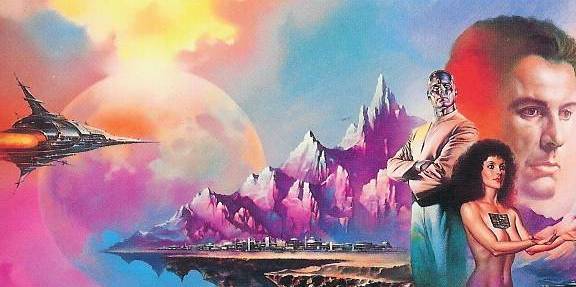
Did William Shatner predict Twitter and Facebook addiction with the fictional cyberpunk drug known as “Tek”? …Maybe. In both the Tek books and television show, this drug took the form of a virtual reality “hit” which seemed to render users completely useless afterwards. The actual manifestation of Tek in the minds of its users seems to usually be generic sexual fantasies. Did anyone ever use Tek just to fantasize about getting a really great job? Or adopting a puppy? Maybe if they had, it would have never been made illegal.
Dust (Babylon 5)
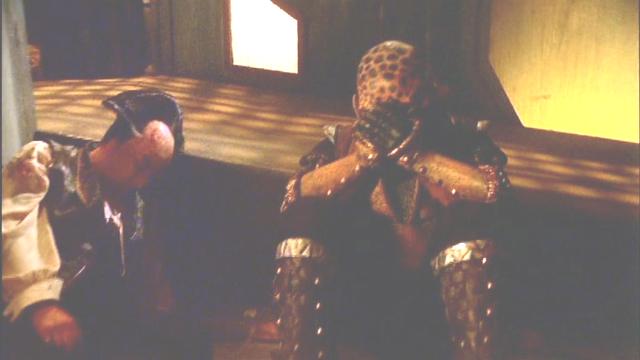
The most we learn about Dust on Babylon 5, other than it being illegal, is that for some reason it turns Narns into telepaths, albeit for a short time. Often, science fiction likes to play with the notion that certain addictive substances can also bring about supernatural abilities. In the B5 universe, Narns are the only species that don’t produce natural telepaths and Dust is the only way for them to access this ability. If telepathy is the norm, just a bonus sixth sense in the future, then this would be like doing a line of coke in order to be able to occasionally see in color. Heavy stuff.
Substance D (A Scanner Darkly)
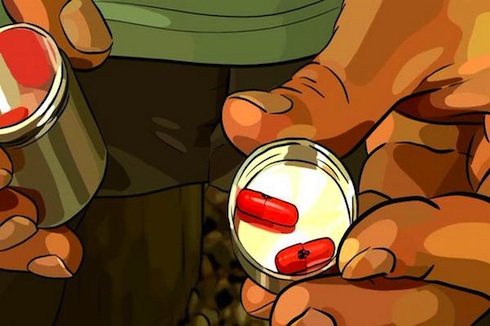
Like many of Philip K. Dick’s fictional drugs, Substance D both darkens and heightens the perceptions its users have of the world. In A Scanner Darkly, the distribution of Substance D is so underground that the police have to go super deep undercover in order to find out who is supplying everyone with Substance D. Every single character seems to be addicted to the drug, making everyone an unreliable narrator. The narrative itself poses the question of what’s worse, here: getting caught with Substance D or being hooked on it forever?
Glitterstim (Spice) + Death Sticks
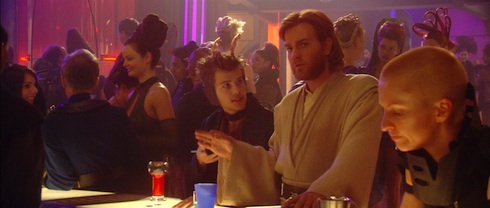
Ever wondered what Han Solo was smuggling when he dumped his whole shipment at the first sign of an Imperial cruiser? It was Spice! Like Dust on Babylon 5, Glitterstim Spice also enables users to read people’s minds. It’s also created by creepy creatures called Energy Spiders, and mining the substance is extremely complicated because of its sensitivity to light. Total darkness is required to harvest it…so when C-3PO bemoaned the notion of being sent to the Spice mines of Kessel, he was really complaining about being in the dark all the time with huge spiders.
As far as Death Sticks, all we really know about them is some dude tries to sell them to Obi-Wan in Attack of the Clones. They sound like a really weak, overt anti-smoking message inserted by Lucas awesome; we need to re-think our whole lives.
Ketracel-white (Star Trek: Deep Space Nine)
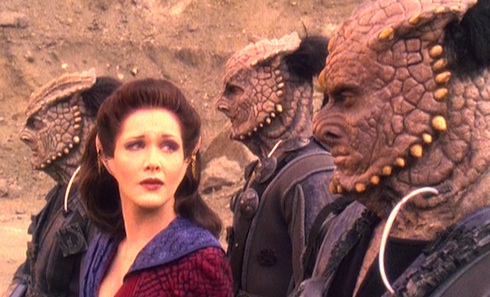
Ketracel-white is a unique drug in the pantheon of science fiction because its primary users are genetically bred to be addicted to it. In order for the Dominion to live up to its scary domineering name, they need an army. The reptilian Jem’Hadar provide this military muscle, but are kept in line by their dependency on the fix regularly provided by their superiors. Institutionalized drug addiction is a scary notion—one also explored by authors like Jonathan Lethem and Philip K. Dick—but when applied to a military complex, it’s made all the more horrifying.
Pan-Galactic Gargle Blaster (The Hitchhiker’s Guide to the Galaxy)
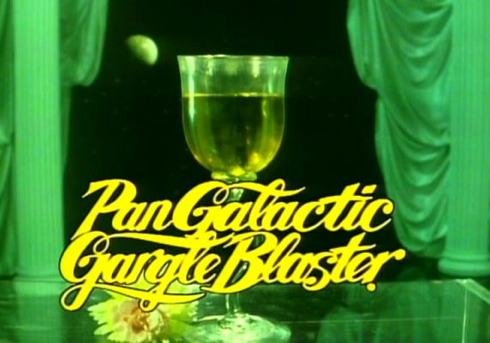
Although conventional wisdom omits alcoholic beverages from lists of hard drugs, we’re giving a special mention to the Pan-Galactic Gargle Blaster on account of it being perhaps the strongest drink in the universe. Its creator, Douglas Adams, likened it to “having your brains smashed out by a slice of lemon wrapped around a large gold brick.” If you survived it, it was probably addictive. You can make it at home and see for yourself.
Retcon (Torchwood)
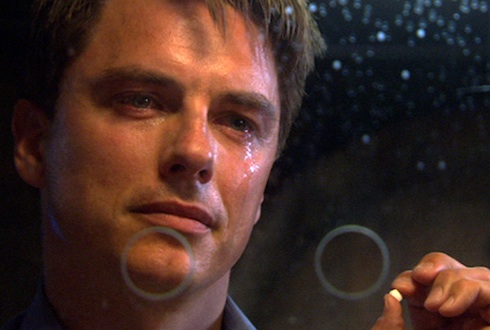
Being a clandestine organization, the Torchwood team frequently needs to make people forget everything they’ve seen or experienced. Enter Compound B67, known more commonly as Retcon. Everyone on Torchwood uses Retcon at some point or another and the potential for abuse is rampant. The drug is also unique in that it’s something you generally administer to someone else (though not always), and that its results (memory manipulation in others) constitute the addictive aspect, rather than the physical effects of drug itself, (although in “They Keep Killing Suzie” we learn that overdosing someone on Retcon can cause psychosis and murderous rage).
Milk-plus (A Clockwork Orange)
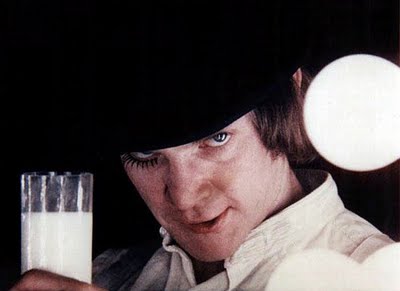
There are a lot of crazy terms in Anthony Burgess’s famous novel, so many that there’s even a glossary in some versions. One of the easier ones to understand is Milk-plus. It’s milk laced with drugs and it makes people act like ultraviolent jerks.
Make (Gun With Occasional Music)
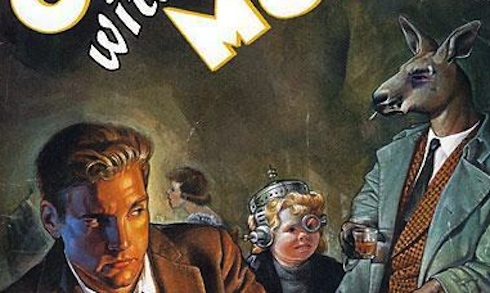
A favorite discussion topic around the Tor.com offices: like Retcon, Make also can cause people to lose memories…but Make is so much more than that. A blend of various types of other future-narcotics such as forgettol and addictol, Make is the ultimate designer drug insofar as each user dictates what goes in their own blend. Further, Make is also an institutionalized, fully legal drug, and users obtain their specific blends at “makeries.” At the end of the novel however, the option of creating your own blend is revoked by the government, rendering this opium of the masses a bona fide tool of societal control.
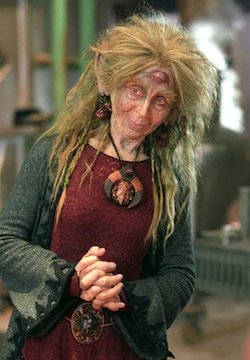 Various Hippie Drugs (Farscape)
Various Hippie Drugs (Farscape)
Farscape’s resident medicine woman, Utu-Noranti Pralatong, was always sticking stuff up people’s noses and blowing powders in the faces of unsuspecting villains. This was probably just as well, since Moya’s crew got themselves into trouble every week (and then some), and sometimes only trippy deception could help them out.
On the other hand, her encouragement of habitual drug use led the show’s main character, John Crichton, to regularly partake of her wares (especially distillate of laka) in order to avoid memories of his derailed romance. Yet again, the drug that gets the primary focus in this show is one associated with forgetting, although this is an intentional fix to forget pain.
Let us know what other fictional potions and powders we should add to the list! And we hope that you enjoyed this post as responsibly as you enjoy the crazy space drug of your choice.
Stubby the Rocket is the voice and mascot of Tor.com. Stubby says say no to space drugs but damned if you can tell.










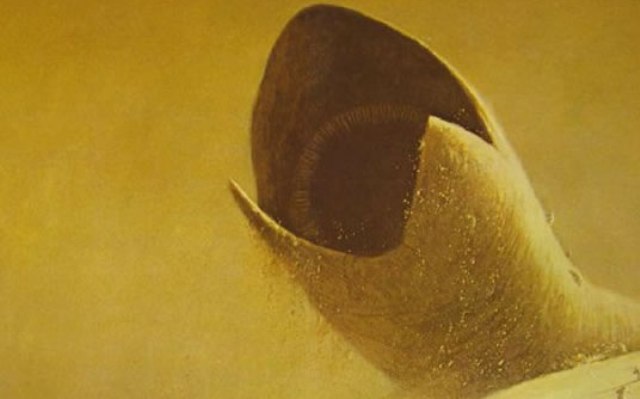
There’s a book by Alfred Bester, Golem^100, in which there exists a radioactive drug that lets you enter the Jungian collective unconscious, which is an actual place / dimension, populated with literal monsters from the id. It is one trippy novel, I have to say.
I’m a bit suprised you mentioned Torchwood without its (in my opinion) strangest drug of all, human beings. In Torchwood: Children of Earth, the 456 basically want children to connect them to themselves and get high on them. Probably not a drug everyon can use, but a drug nonetheless.
There’s a typo in Ketracel-white: “depnedency”
There’s whatever the bad guys use to control the middle to upper status people in Bill Baldwin’s Helmsman series – in purpose, it’s similar to ketracel-white.
There is another interesting one from the original Dune series, something called “semuta”. It is taken in combination with listening to special musical compositions that trigger and/or heighten the effects of the drug, so characters in the book would be sitting in a trance-like state of euphoria listening to music. Sounds kinda like some old ’60s hippies I know.
@3 Thanks Tim–fixed now. Also: for some reason I keep getting the “Teamocil” song from Arrested Development stuck in my head every time I look at this post. Not a space drug, but…catchy theme song :)
I was always fascinated by a phenomenon in Larry Niven’s Ringworld books where people could get a rig surgically installed in their heads allowing a light current to be plugged into the pleasure center of the brain. I think they were called “wire-heads”. People would get so hooked on it they would eventually just stay plugged in and stop eating and just die.
Don’t forget Nuke in Robocop 2. Of course there is also Snow Crash in Neil Stephenson’s book of the same name.
And in the beginning there was Thionite, peddled by zwilnicks Thionite basically triggers every neuron in the pleasure center of the brain.
In Sci-fi drugs I would actually think about taking; Piers Anthony created NEEM, which grants eidadic memory while in effect.
I was a bit surprised to notice Norman Spinrad’s tale of drug-fueled transcendence “Subjectivity” ran in squarer-than-square Analog under John W. Campbell, Jr. Now that I am reminded of Dune, also featuring drug-fueled transcendence, also published in squarer-than-square Analog under John W. Campbell, Jr., I wonder just how common drug-fueled transcendence was in the last decade of Campbell’s Analog.
You know, I am a firm supporter of Ben Bova’s editorial years at Analog but now I wonder if perhaps Robert Anton Wilson might not have been a more appropriate choice for editor.
Rothfuss has denner resin which plays a significant role in The Name of the Wind.
#9–yes! thionite was my first thought as well; the description of the planet it came from was one of the more entertaining bits of Smith’s invention. But drugs appear with a lot of the bad guys & having the hero use drugs as part of his cover seemed pretty daring (at least when I read Smith in the 80s). As I recall, that eating the “life force” of the Dragon Lensman’s people was an addiction of the oppressor species, rather than a dietary need–sorry, I forget the names after so long.
I thought of Villa on Blake’s 7 and his Soma, (although this looks/sounds like the same thing from Brave New World.)
Also, there was something called Flash on the Andromeda tv series that was administered through the eye that supposedly helped them traverse slipstream.
I’m thinking of Walter Jon Williams Angel Station where they had various intelligence enhancing drugs that were inhaled or injected. Very expensive as everyone who wanted an edge used them and they were in short supply. The two main charactors discover an alien race that can produce this stuff wholesale as their entire technology is biologically based.
Slurm from Futurama, it’s like mountain dew flavored melange, it even comes from a ginormous worm/slug
Mindtrap. From ‘Dramatic Mission’ in the Ship who Sang anthology. It’s a safe addictionless drug that grants perfect recall. One of the major charecters is dying of it however because he can’t stand forgetting anything and he has a genetic condition that makes it damage his bones.
For some reason you’re forgetting stroon – santaclara – which extends lifespans, but with side-effects such that Norstrilians prefer to die after a good thousand years, and the Instrumentality only permits those who would otherwise betray it, thousand-year lifespans. I suppose the side-effects tear you apart after the first seven hundred, so it’d be not such a win after all.
And of course condamine, so powerful a narcotic it must not be mentioned in public, and such a strength that it can only be counteracted by typhoid fever acting as an inoculation.
Damn, I need to remember the name of this brazilian sci-fi/comedy book in which Earth is under constant surveilance because chocolate is a drug that gives the aliens some sort of deadly high…
You had Farscape in there, but then totally didn’t mention that the series finishes on what is basically an interstellar drug war instigated by the Scarrans because of a flower that grows pretty damn well here on Earth and almost nowhere else in the Galaxy.
Considering our homeworld is nearly destroyed over a drug-war, it was kind of an important one to miss when the series was already mentioned!
In Iain M. Banks’ Culture novels. The citizens of the culture have drug glands inside their bodies and are able to produce powerful coctails of drugs for each and every occasion.
The lead character in the player of games expecially uses these to enable him to play games better. No Dealers necessary or maybe the whole society is a dealer.
I am always surprised that no one ever mentions Stanislaw Lem’s The Futurological Congress in these kinds of threads. The entire premise of the novel is drugs.
Another tech-version-of-drug was the SQUID playback machines in the movie Strange Days. There was a whole black market in trading in people’s memories. Movie presented it pretty well, too.
No mention of plutonium nyborg the cult classic Heavy Metal?For shame :)
Thionite. Doc Smith. No more need be said.
In John Ringo’s “Live Free Or Die”, Tyler Vernon discovers that an alien race, the Glatun, get really stoned from maple syrup.
On MAR Barker’s world of Tékumel it is socially acceptable to use the ‘powders,’ especially at a feast or party but they are never given to children. Unless one is a follower of Dlamélish or Hriháyal (Goddesses of Living in the Now), it is considered undignified to become intoxicated.
There are many varieties:
Hnéqu weed, a red-brown grassy plant, is chewed to give a mild euphoria.
Chümáz, a bluish-white powder made from a Livyáni berry, heightens perceptions and acts as an aphrodisiac.
Drársha, a clear crystalline drug made from a Salarvyáni shellfish, causes amusing distortions of vision and time.
Ntó, a fine white dust shaken from the leaves of a tree growing in M’mórcha and Nmartúsha, gives one giddy joy.
Mághz, a brown powder made from the bark of a tree growing in the far northeast, elicits a drowsy peaceful mood.
Osí, a thick greyish mucus scraped from the bones of fish found around the Nyémesel Isles, reduces tension and arouses the libido.
Many varieties of Tsuhóridu (a distilled brandy-like liquor) are made using these drugs.
These drugs are neither addictive nor toxic unless used in excess.
Amd then there is…
Zu’úr, a greenish powder, causes erotic arousal. It is instantly and incurably addictive, deadly and a capital crime to possess, use or sell.
Never. A Fairy drug created by Holly Black in Valiant. It is a drug that keeps the Fey healthy in the heavily iron laced atmosphere of our cities. On the other hand it is a highly addictive drug for a human and it embues the user with fairy capabilities and magic.
Bloodhype, the titular drug from a novel in Alan Dean Foster’s Flinx of the Commonwealth series.
It is instantly addictive, extremely powerful, and the one drug in the Humanx Commonwealth whose distribution carries an automatic death penalty.
Dreamshit from Perdido Street Station… That was some drug!
Curdled milk got the Aliens in Alien Nation messed up.
“Soy Sauce” from John Dies at the End. I don’t even know how to describe the effects. Book by David Wong. I have only seen the movie. Weird, weird movie but I love it. It has sci-fi elements.
CAN-D and CHEW-Z from PK Dick’s “The Three Stigmata of Palmer Eldritch”. Each of them allow users to share a common halucination. CAN-D’s is a relatively benign but shallow fantasy, but CHEW-Z’s is able to be controlled by the titular Palmer Eldritch.
DREDD (2012) – Slomo
super–condamine from “A Planet Named Shayol” sounds like an amazing drug, even if you have to go through terrible pain before you are able to use it.